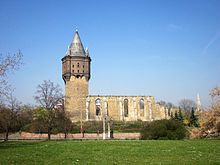St. Sixti (Merseburg)
St. Sixti is a former church in Merseburg . The Kirchenruine stands as a monument under preservation and is monument directory recorded with the number 094 20,287th
Location and history
The church was founded in 1045 by the Merseburg bishop Hunold. In the middle of the 13th century, a new building took place under Bishop Heinrich von Wahren and in 1327 it was elevated to a collegiate church. It became the impressive church of its own quarter ( Sixti quarter ), gave its name to streets ( Sixtistraße ), squares ( Sixtihügel ) and the nearby city gate ( Sixtitor ), and in 1454 it was given a huge tower dome that was higher than the stone structure of the tower itself. It was considered an ornament of the city and also had the most beautiful chime, a carillon consisting of three bells. In the early 16th century, the construction of the late Gothic nave began, but was never completed.
With the Reformation the collegiate monastery was transferred to the cathedral freedom and the church was increasingly abandoned. From 1563 onwards, no more priest was appointed, two years later the organ was brought to the town church of St. Maximi and in 1611 the altar was moved to the Gottesackerkirche (later also to St. Maximi). Only the bells were still useful, as the ringing of the town church had meanwhile become a danger to the tower's statics. The orphaned cemetery at the church was only used for those who were refused a burial in the St. Maximi city cemetery , such as suicides or people of different faiths.
The building has been in ruins since the Thirty Years War . Attempts to rebuild it at the end of the 17th century failed because of the inconsistent pursuit of the plan. Again and again, the church's fate was the very high dome, into which lightning often struck (1697, 1753, 1768, 1845, 1865). When it fell in 1865, the bells were also destroyed. Since there were two churches with non-functioning carillons, it was decided to keep the town church and turned the church ruins into a garden that was regularly leased from 1849 to 1911. During this time, metal finds from the ruins were also sold, including the unusable bells.
When looking for a high reservoir, the Romanesque church tower was found, stabilized and converted into a water tower in 1888/89 . Since at the same time the German Emperor Friedrich III. died, the church tower was renamed Kaiser-Friedrich-Turm and a relief plaque was made. Since this failed, money was collected for a real memorial, which was finally erected on the school square. In 1922 the ruins were turned into a children's playground, and plans for the following decades regularly failed. In 1974 the redesign as an open-air museum began.
literature
- Georg Dehio : Handbook of the German art monuments. Saxony Anhalt II. Administrative districts Dessau and Halle. Deutscher Kunstverlag, Munich / Berlin 1999, ISBN 3-422-03065-4 , p. 556.
- Renate Endler: The Sixtiviertel - a missing part of the city of Merseburg. Part 1: The Church of St. Sixti , in: Merseburg once and now 15 (2006), pp. 7–38 & 16 (2006), pp. 4–32.
Web links
- Church ruins St. Sixti. merseburg.de, accessed on April 9, 2017 .
- St. Sixti , Merseburg in the picture, accessed on November 14, 2018
Individual evidence
- ↑ List of monuments of the state of Saxony-Anhalt (pdf) - answer of the state government to a small question for written answer (the MPs Olaf Meister and Prof. Dr. Claudia Dalbert; Bündnis 90 / Die Grünen) - printed matter 6/3905 from March 19, 2015 (KA 6/8670)
Coordinates: 51 ° 21 ′ 6.7 ″ N , 11 ° 59 ′ 48.3 ″ E
